It was a day with tears of joy and sorrow when villagers in Siaolin Village (小林) in Kaohsiung County’s Jiasian Township (甲仙) held their annual Arit Festival on Saturday, nearly three months after their village was almost completely buried by mudslides.
“Arit” is the word in the Siraya language for “ancestral spirit.” For the Sirayas, the annual festival to pay homage to the Arit is their most important religious event.
The Siraya are an Austronesian people who once inhabited flat lands in parts of southern Taiwan. However, throughout the past centuries, many Siraya have adopted the Han Chinese culture, resulting in the loss of tribal identity and culture, or they have been forced to resettle, such as the Siraya in Siaolin, who originally lived in Yujing (玉井) and Nansi (楠西) townships in Tainan County.
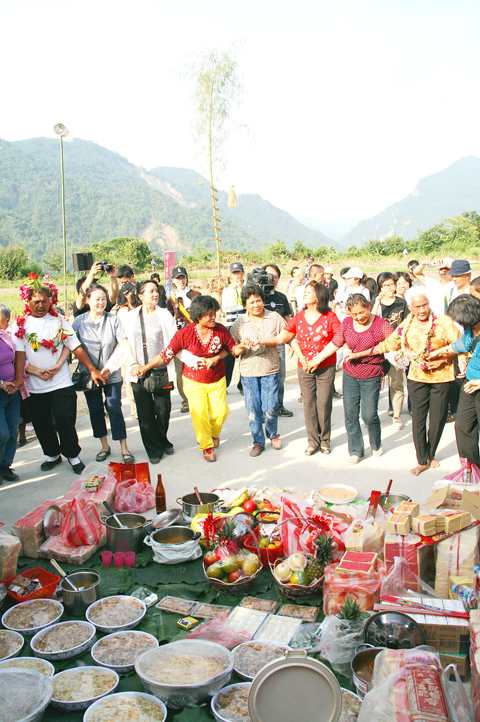
PHOTO: LOA IOK-SIN, TAIPEI TIMES.
The Siraya are not recognized as one of Taiwan’s 14 Aboriginal tribes.
Despite having lost more than 500 people when Typhoon Morakot triggered massive landslides that buried most of the village in August, the remaining Siaolin villagers and those who lived outside the village decided to continue the tradition.
Even before a plan to reconstruct their village has been finalized, Siaolin villagers have already rebuilt their kuva — a place of worship and meeting — in nearby Wulipu (五里埔) Village.

PHOTO: LOA IOK-SIN, TAIPEI TIMES
The kuva is more commonly known by the Hoklo (also known as Taiwanese) term konkai (公廨 or 公界), or “the public place.”
Although the destroyed Siaolin kuva was built in wood, the villagers decided to build their new kuva in the ancient way, using only bamboo for the structure and dried grass for the roof.
Following tradition, one group of villagers headed into the mountains at 6am to find bamboo to be erected in the square in front of the kuva. They believe that the Arit would descent from the Heaven via the decorated bamboo.
Meanwhile, another group of people were busy making repairs and decorating the kuva.
One after another, villagers entered the kuva with offerings for of betel nuts, cigarettes, rice wine and food.
Although the people are as sincere and as serious about the ritual as they have always been, the atmosphere on Saturday was filled with sorrow.
“The annual Arit Festival in Siaolin is the time of the year when young people working elsewhere in the country would come back for family reunions and enjoy time with their families and childhood friends,” Jiasian Township Mayor Liu Chien-fang (劉建芳) said. “But this year, when the young people return, they only find their homes destroyed and their parents gone.”
An elder village woman surnamed Pan (潘) said that the village suffered such a disaster because the people must have done something wrong to upset the Arit. She said she hoped that by paying homage to the Arit the ancestral spirits would bring peace and prosperity to the village in the coming year.
“This is so sad that something like this happened to us and took so many lives — this is why we won’t qianxi [牽戲] this year, nobody is in the mood to do so,” Pan said. “Maybe we’ll qianxi next year if things get better.”
Qianxi is the singing and dancing part of the Arit festival.
Siaolin tradition says qianxi in the afternoon is a way to communicate with the Arit while qianxi at night is for entertainment.
A screening of a documentary of Siaolin Arit Festival in 2007 and an exhibition of photos of Siaolin were shown outside the kuva on Saturday. Dozens of villagers searched for deceased friends and relatives, as well as their buried homes in the film and in the pictures.
“You see, the little girl dancing there is my brother’s daughter. She’s gone and so is her father,” a teary-eyed 71-year-old Mao Yu-chu (毛玉珠) told the Taipei Times as she watched the film. “Now that’s my sister dancing. She didn’t make it out either.”
When Siaolin was buried by massive landslide on Aug. 9, Mao lost her sister, her brother, her brother’s family, her daughter and her son-in-law Liu Jen-ho (劉仁和), who was the village chief.
“I was ill at the time and was in hospital in Kaohsiung City,” she said. “I went into the hospital on Wednesday, and was supposed to come back on Sunday, but the village was gone on Sunday morning.”
The ancestral spirits seem sadden by the tragedy as well.
After two shamans whom the villagers believe to have been possessed by ancestral spirits talked in the Siraya language for a while, they both started to cry.
Several nearby villagers began to cry as well.
However, the sorrowful atmosphere was lifted at the end, when the shamans declared that the Arit were pleased by the feast and wanted everybody to dance and sing a traditional tune.
The villagers were reserved at first, but after a while, more people joined. They danced around a pole in the kuva that represents the Arit’s army, sang and drank the rice wine that was passed to them.
“This is how we Aborigines are — we can easily heal ourselves and look forward,” said Tsai Sung-yu (蔡松諭), chairman of the Siaolin Self-Help Association.
“Every crisis presents an opportunity,” Tsai said. “If it wasn’t because of the tragedy, so many of the young men from Siaolin would not have gathered here again to talk about how to reconstruct our own community and how we want it to be in the future.”
Like many of the younger generation in Siaolin, Tsai, in his 30s, has been living and working in Taipei. He said, however, that he was considering moving back.
In the past, everything was taken care of by the village elders, but now the young people must live on their own, he said.
“Of course I’m in deep grief — I’ve lost my parents, and all my childhood memories are buried deep underneath,” Tsai said. “But this is exactly why we, the younger generation of Siaolin villagers, must shoulder the responsibility to rebuild our homes and pass on our traditions.”
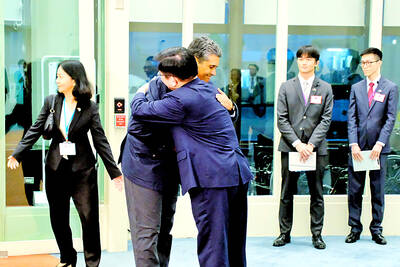
Palauan President Surangel Whipps Jr arrived in Taiwan last night to kick off his first visit to the country since beginning his second term earlier this year. After arriving at Taoyuan International Airport at around 6:30 pm, Whipps and his delegation were welcomed by Minister of Foreign Affairs Lin Chia-lung (林佳龍). Speaking to gathered media, the Palauan leader said he was excited and honored to be back in Taiwan on his first state visit to Taiwan since he was sworn in this January. Among those traveling with Whipps is Minister of State Gustav N. Aitaro, Public Infrastructure
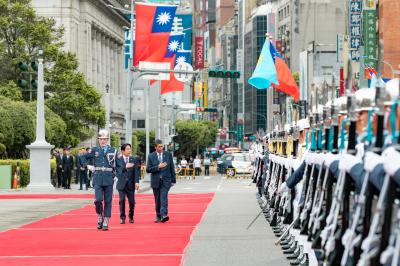
President William Lai (賴清德) yesterday thanked Palau for its continued support of Taiwan's international participation, as Taipei was once again excluded from the World Health Assembly (WHA) currently taking place in Switzerland. "Palau has never stopped voicing support for Taiwan" in the UN General Assembly, the WHO and other UN-affiliated agencies, Lai said during a bilateral meeting with visiting Palau President Surangel Whipps Jr. "We have been profoundly touched by these endorsements," Lai said, praising the Pacific island nation's firm support as "courageous." Lai's remarks came as Taiwan was excluded for the ninth consecutive year from the WHA, which is being held in
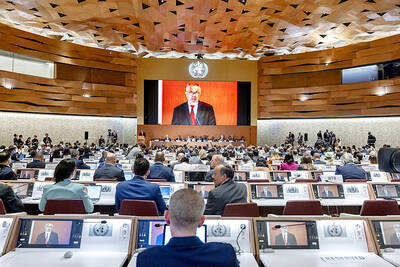
RESOLUTIONS DEBATE: Taiwan’s allies said that UN and WHA resolutions cited by China and other nations ‘do not determine Taiwan’s participation in WHO activities’ A proposal to invite Taiwan to this year’s World Health Assembly (WHA) was rejected on Monday, resulting in Taipei’s absence from the annual meeting for a ninth consecutive year, although partners spoke up for Taiwan’s participation at the first day of the meeting. The first agenda item after the opening was a “two-on-two debate” on a proposal to invite Taiwan to participate at the WHA as an observer. Similar to previous years, two countries made statements in favor of the proposal, while two others expressed their opposition. Philippine Secretary of Health Teodoro Herbosa, president of the 78th WHA, accepted the WHA General Committee’s
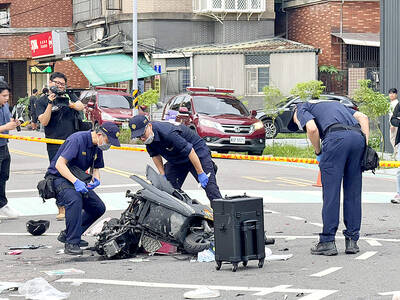
At least three people died and more than a dozen were injured yesterday afternoon when a vehicle struck a group of pedestrians in New Taipei City’s Sansia District (三峽). The incident happened at about 4pm when a car rammed into pedestrians at an intersection near Bei Da Elementary School. Witnesses said the sedan, being driven at a high speed, ran a red light, knocking scooters out of the way and hitting students crossing the road before careening into a median near the intersection of Guocheng and Guoguang streets. The incident resulted in three deaths and 13 injuries, including the driver, a 78-year-old man